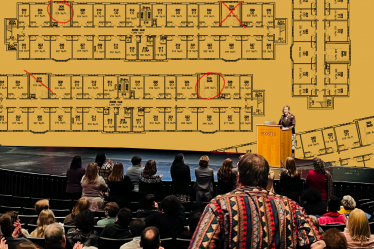
Campus dining has reported that over 2500 boxes have gone missing from their stock since Aug. 2023. Graphic by Julia Garrison.
Zanna Anderson
Contributing Writer
Green to-go boxes are going missing, and custodial staff have reported finding hundreds of containers in trash cans across campus. Since the creation of the green box system more than 12 years ago, there has never been such a mass disposal of these receptacles. The current problem started at the beginning of the COVID-19 pandemic.
Before COVID, the College typically replaced the boxes after 200 to 300 uses according to Marjorie Shamp, director of campus dining. Every student automatically had one green box on their meal plan account that could be checked in or out with the cashier payment method. During the first couple months of COVID, the green box system was temporarily suspended because there was not yet evidence of how the virus spread. To protect dining staff and students, green boxes were replaced with disposable, single-use options.
In 2022, campus dining services outsourced their production services to Creative Dining Services, a company that manages dining for several midwestern colleges. This shift was accompanied by a change in the point of sale system, which does not include the element of accountability that previously existed. Green boxes now only tend to live through 100 to 150 uses before they are thrown out.
Since Aug. 2023, campus dining has ordered 3000 new plastic boxes to replace boxes that have been discarded across campus. Additionally, the constant purchasing of new plastic boxes has cost campus dining services upwards of thousands of dollars.
“[Purchasing new boxes] kind of defeats the purpose of being sustainable,” Shamp said.
Shamp estimates that Lowry has lost up to 3000 boxes to landfills since August. Wooster students have likely contributed to an estimated 1000 pounds of plastic waste in green boxes alone.
Campus dining’s budget was not constructed to support frequent purchasing of green boxes, and campus dining is suffering as a result. Campus dining is using funds meant to cover replacing silverware, mugs and plates. As the green box spending amount supersedes the budget constraints, ingredient spending and dining staff salaries could take a hit.
The purpose of the green box system was to provide a flexible dining option to students unable to eat their meals at traditional times. Without this system, students would be pigeonholed into using flex dollars to cover their food costs or eating the limited options at Mom’s Late Night.
However, Shamp stated that she would “fight hard” against the elimination of the system. Consequently, Shamp called upon students to reflect individually and understand the purpose of the green box system: to make food accessible to every student in an environmentally conscious manner. According to Shamp, students’ disposal of reusable containers betrays the system’s purpose and the wellbeing of fellow students.
Shamp and Brian Webb, director of campus sustainability, are currently working on a way to reimplement accountability into the system. They hope to implement software that allows students to scan their own box in or out using an app. This app would send the user notifications if the box has not been returned within a certain timeframe. However, this app would involve a large start-up cost to fund the software creation and the production of the individual labels for each box; therefore, there are no current plans to change the system.
Moving forward, cost will play an important role. The campus dining budget has already suffered immense losses this academic year. For now, students must hold each other accountable for returning to-go boxes in order to ensure the quality of campus dining for students and staff.

